Student Blog
Classes

Take a Peek at Pediatrics! ⟩
October 11, 2017, by Caroline
Classes
Whenever I give prospective students a tour of our facilities and classrooms during Information Sessions, the Pediatrics classroom tends to get a lot of “oohs” and “aahs.” Rightfully so! Half of the classroom is filled with colorful things to jump on, climb on, swing on, and crash into, which certainly looks a lot more fun than most classrooms I’ve seen! OTs who work in Pediatrics definitely try to make everything they do with their pediatric clients fun and engaging, and the same can be said for our Pediatrics professors. I spend 9 hours each week in my Pediatrics class, but it’s so much more than a lecture with my professors talking at me the whole time! The course integrates team application activities, case studies, and a lot of exploring and trying out different assessment and intervention approaches.
I’ve already told you about my Fieldwork experience in a school-based setting, but now let me give you a peek into my Pediatrics course!
I don’t have pictures for privacy reasons, but we had the opportunity to interact with children and with parents when learning about doing parent interviews and conducting standardized assessments. As a class, we got to practice interviewing a parent of a child who receives OT services, and he was able to give us feedback about how we did. Additionally, professors bring their children into the lab, so we can look at their primitive reflexes and learn about how to conduct standardized assessments. We learned that it’s a lot harder than it looks, but that it becomes easier as you get more familiar with the assessments.

Different snacks used for a grasp analysis activity
When learning about different grasps (how we manipulate our fingers and hands to grab objects) our professors brought in some snacks. Grabbing yummy snacks and bringing them to our mouths was definitely an inherently motivating and fun way to review the various types of grasps. I realized that we grab a sunflower seed differently than we grab something bigger like a cheese-it, which is something I hadn’t thought about before. Next time you’re eating a snack, pay attention to how you pick up your food to eat it!

We planned a treatment using Connect 4 and Play-Doh
When practicing planning treatments that address different fine motor skills, our professors put random objects on the table and told us to come up with a fine motor skill treatment using those objects on the spot! My group had play-doh and Connect 4, so we decided to hide the Connect 4 pieces inside the play-doh. That way, by manipulating the play-doh, the child is building up strength in the small muscles in their hands. Then, we can address grasp when looking at how they hold the Connect 4 pieces. We also came up with ways to change the activity to make it more challenging and less challenging. It may look simple, but there’s a lot of thought behind each pediatric treatment!

Lots of different games can be used in OT!
When learning about visuomotor integration (how our vision and perceptual skills work with our fine motor skills to help us interact with our environment efficiently), we got to try out a lot of different games and think about how they could be used in treatment. One of my professors said something that really stuck with me: generally, the children that OTs work with may have a hard time playing a game exactly as it is designed or following the exact direction. This means that it’s the OT’s job to adapt the game and make it the right challenge for each child, allowing them to work on certain skills, but feel successful and have fun at the same time. OT treatment with children can often look like play, but there is a lot of work going on at the same time!

Some of the materials used in the Handwriting Without Tears Program. I practiced using the wooden blocks to put together a few letters!
When learning about handwriting interventions, we got to explore the Handwriting Without Tears program, which aims to do exactly what the name sounds like! For children who have a hard time learning to write or making their writing legible, working on handwriting in therapy could start to feel boring and like work, so a couple of OTs created the Handwriting Without Tears program to make handwriting intervention more dynamic and fun. Children can practice writing on an etch-a-sketch and chalkboards and can form letters with play doh and wooden blocks. This program uses a multisensory approach and has a lot of different options to make treatment fun and different. I’ve used this program used at my fieldwork site, and the kids definitely enjoy it!

Getting a little vestibular input from one of the swings!

Check out some of my classmates on other swings!
Finally, last week we were learning about Sensory Integration theory and intervention, which was actually developed by A. Jean Ayres, a former OT faculty member here at USC! We learned all about our sensory systems, how they’re supposed to work, what it can look or feel like when they’re not working as they should, and what Sensory Integration can do to help. My professor reminded us that you should always try out an activity yourself before having a child do the activity in therapy, to ensure that it’s the right level of challenge and actually addresses what you want the intervention to address. So, we did exactly that! We explored the lab space and got on different swings and equipment to see what it feels like, how challenging they are, and how our bodies feels afterwards. It was such a fun day!

Just two peas in a pod getting some tactile input!
I’m so appreciative of all of the time and effort my professors put in when planning the course and the time spent in the classroom. I’m definitely a learn-by-doing kind of person, so I love when I get to be hands-on in the classroom. My pediatrics midterm is coming up next week, so I’m definitely starting to reflect on everything I’ve learned this first half of the semester. Wish me luck!
⋯

Standardized Patients: the Good, the Bad, and Becoming the Hulk ⟩
October 6, 2017, by Erika
Classes What are OS/OT?
One of the best opportunities our program offers is the chance to practice transfers with standardized patients in our Adult Rehab immersion.
What’s a standardized patient?
It’s a person carefully recruited and trained to take on the characteristics of a real patient providing students with the opportunity to learn skills in a simulated clinical environment. Neat, right?
So far in my adult rehab immersion, we’ve practiced with standardized patients “recovering from hip replacements, back injuries, and stroke.” We’ve learned how to transfer them from laying in bed to sitting then to a wheelchair or walker! From there, we’ve also practiced how to mobilize and transfer these patients to the shower, tub, and toilet.
It’s been ADLmania!!!
Our Adult Rehab lab was designed to simulate common practice locations where we would actually conduct transfers and treatment sessions. On one side, we have an exact replica of what a hospital room looks like at Keck Medical center — from the beds to the toilet and shower. On the other side, we have a standard bedroom with access to a tub and toilet. Lastly, we have a fully functioning kitchen where we can practice various occupations like meal prepping, washing dishes, and cooking. What’s better than practicing real life occupations in a real life setting?



Readers, can I just say, the first time I practiced with standardized patients, I. Was. Terrified.
“I have NO clue what I’m doing. Are they going to be nice? Are they going to be painfully dramatic? Am I going to drop someone and break their hip a second time?”
My stream of consciousness spiraled into the dark depths of the unknown but of course, with all new experiences, it wasn’t as bad as I thought it was going to be.
Sure, I think all of us students will admit that the first time, there was a lot of “uhhhhh . . .”s, big perplexed eyes, and unnecessary overexplanations of the protocol running through our heads and out our mouths. After that though, you realize that the standardized patients aren’t there to give you a hard time or to give Oscar-worthy dramatic performances but are there for you and your learning experience. While at times, they were committed to simulating pain (which was intimidating at first), they were incredibly kind and open to providing feedback on why they felt pain or felt discomfort. They were gracious in giving us as many opportunities to try again to make sure we get a specific transfer or handling right.
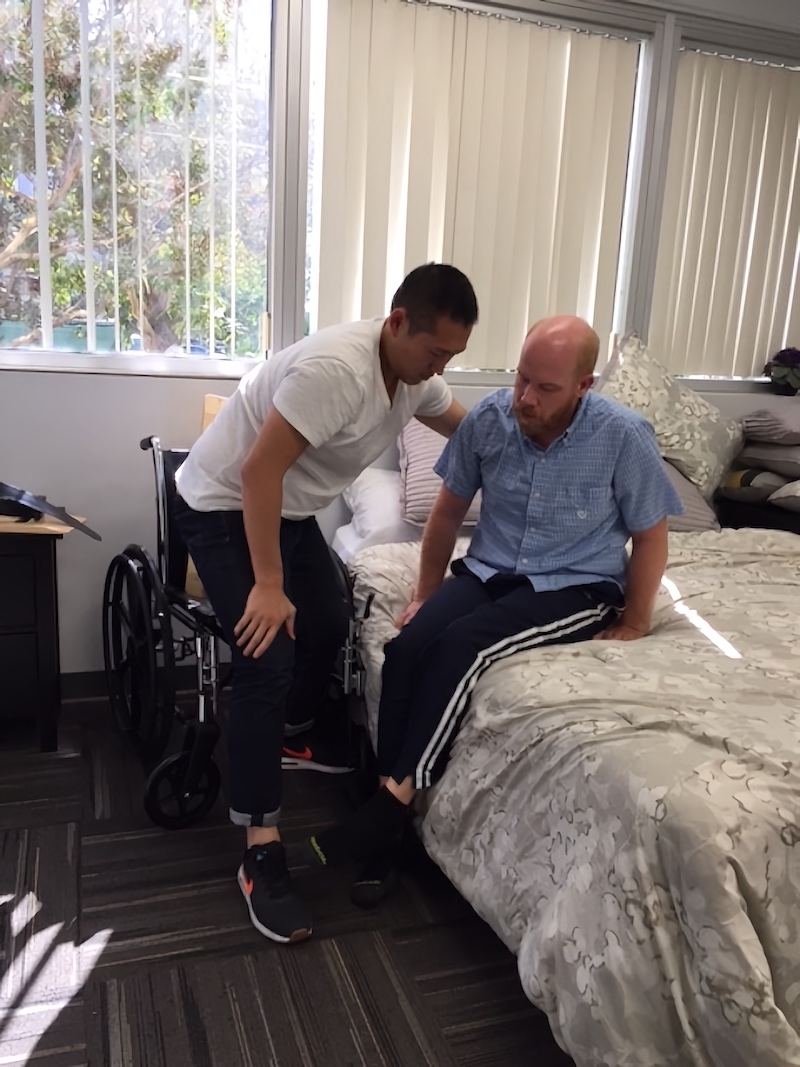

At the end of the day, that’s what makes the opportunity of practicing with standardized patients valuable — it gives us the opportunity to spiral into our own fears then build ourselves back up with the support and feedback of our professors and standardized patients to reveal our own capabilities and strengths — all within a safe learning environment!
I want to close with some advice I was given while working with a standardized patient named Mel*. After I had transferred him, he looked me straight in the eye and said, “You have to commit. If you don’t commit, I won’t commit.” I’m not sure if this was a reflection of his practices as a method actor, but it completely changed how I transferred after that point. I became more confident. You know when Bruce Banner becomes the Hulk? It was like that without all the rage. Mel’s words transformed my identity from being a timid inexperienced OT student to a potentially strong, capable, and committed OT practitioner. Thanks Mel.
*All names mentioned in this blogpost are pseudonyms.
⋯

Summer In Full Swing ⟩
July 5, 2017, by Jessica P.
Admissions Classes Fieldwork International
Summer is in full swing and we have been busy keeping up with all of the exciting things happening at Chan!
Just a few weeks ago we had the pleasure of officially welcoming our class of 2019 to the Trojan family! Our new Trojan OTs are busy this summer taking courses in kinesiology, neuroscience, foundations of occupation and creativity, craft, and activity analysis.

USC Orientation Week
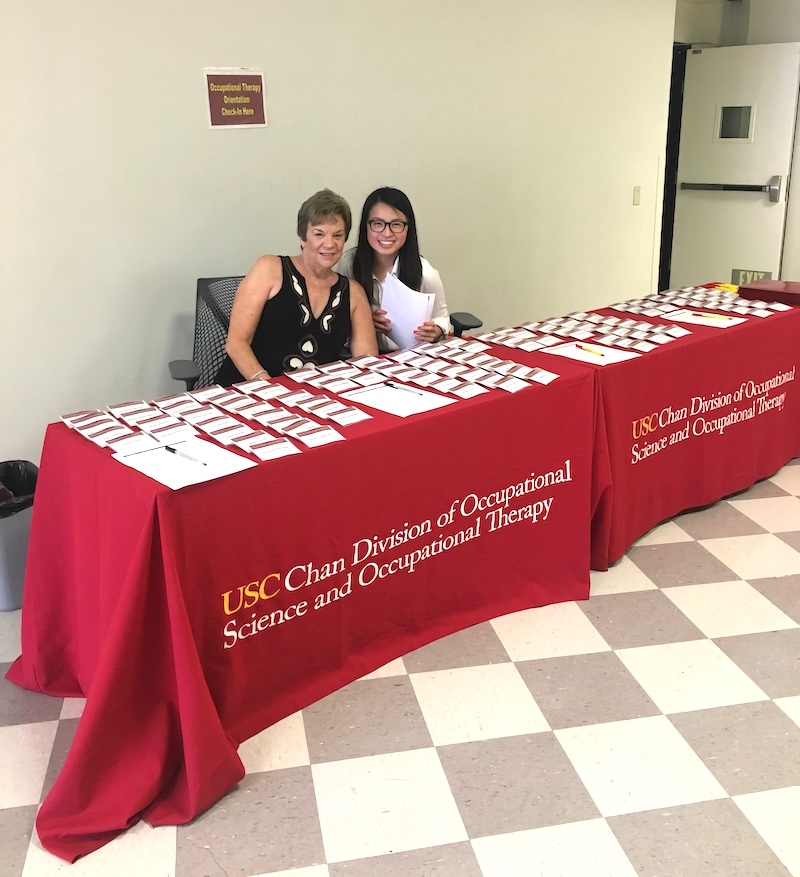
USC Orientation Welcome

Summer CAs fighting on
Our continuing students have also been busy completing their Level II Fieldwork at various sites across the states.

Summer Level 2 Fieldwork — Ali
One of our students, Ali, is completing her fieldwork at Coastside Pediatric Therapy Center. She loves learning about playing with a purpose and the science of development.
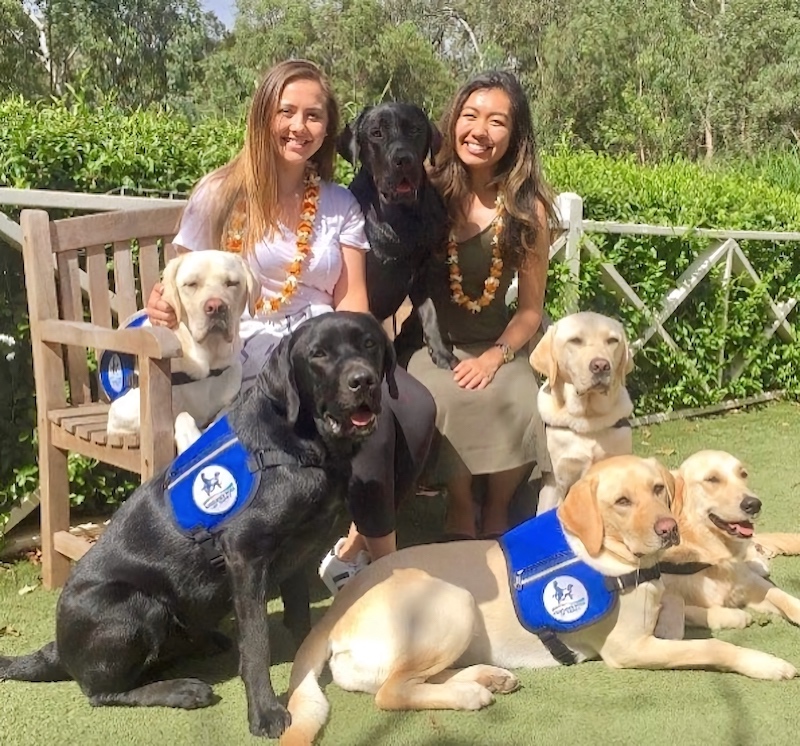
Summer Level 2 Fieldwork — Brynne and Kaitlyn
Two of our other students, Brynne and Kaitlyn, are completing their fieldwork at Assistance Dogs of Hawaii.
As a student ambassador I have been having a blast meeting all of our new and prospective students. Our Information Sessions are a great way for us to meet students and for them to learn more about our program.

Info Session 2017
This past weekend we also had the pleasure of welcoming 50 international OTs and OT students for our Summer Occupational Therapy Immersion (SOTI) Program. The participants will spend the next four weeks learning about OT in the United States, attend seminars, visit various OT sites, and of course enjoy all of the fun that Los Angeles has to offer!
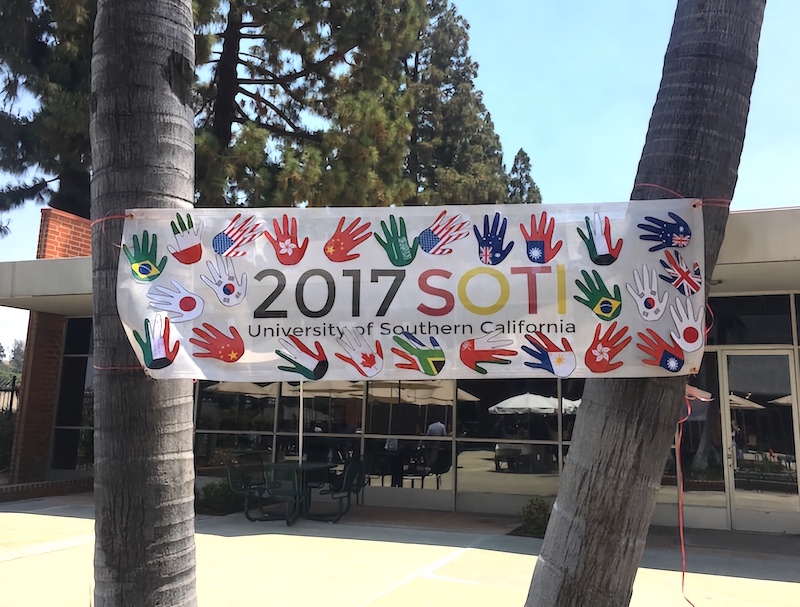
SOTI Welcome BBQ 2017
With summer half way over, we are excited to fight on and enjoy the next few weeks full of sunshine and OT fun!
⋯

Momma, I Made It! ⟩
June 27, 2017, by Erwin
Classes Community Getting Involved School/Life Balance
Wow! Where has the time gone? It really seems like yesterday that I was a newly-admitted student walking on campus for the first day of classes. My time at USC has been nothing short of amazing and I can honestly say that I’ve grown so much here — not only as a therapist, but as a person.
Looking back at my career at USC, here are my few words of wisdom:
Learn: Don’t study for the sake of passing a class. This isn’t undergrad anymore; what you’re learning in occupational therapy school is going to be your craft. So don’t come in with the mindset of, “I need to get an A in this class.” It’s much more important to really understand the material and knowing how to apply it rather than knowing how to get an A. After all, an employer isn’t going to ask what your GPA was — they’re going to care if you’re good at what you do.
Get involved: USC has so many opportunities to get involved and it would be unfortunate not to take advantage of these opportunities. Exploring different opportunities allows you to discover your passions and strengths, connect you to USC, foster community, and build your resume. While at USC, I tried to get involved as much as possible. I’ve developed my leadership skills, built life-long friendships, and opened doors that would not have been possible.
Enjoy yourself: Graduate school can be stressful. There will be papers, exam, and projects — you might even question, “is this really worth it?” Just relax! We always encourage our clients to live balanced lives and we have to practice what we preach. After all, a balanced life is a healthy life. So while in grad school, take time to take care of yourself, enjoy the company of others, and don’t stress out too much about your classes. Like I said before, employers aren’t concerned about your grades.
Although graduation has arrived, I know what I’ve learned at USC will carry on throughout my lifetime. Occupational therapy is such a beautiful and rewarding profession, and regardless if you pursue a degree at USC or another university, the profession will be nothing but good to you.
Before I go, I want to share with you some of the people and moments that have meant the most to me while at USC.

White Coat Ceremony 2015

Dr. Delgado and his student delegates!

Philippines Externship team!
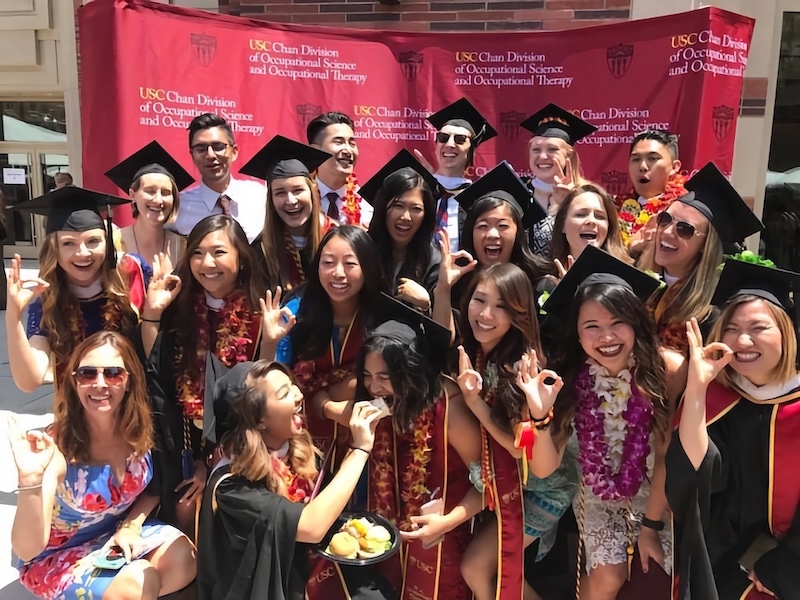
Cohort B(est)

My amazing ambassador team 😊
⋯

Autism in the Community ⟩
February 13, 2017, by Kimmy
Classes Community What are OS/OT?
As prior blog posts have mentioned, the final semester of the program is full of unique electives. These classes range from lecture-based courses in advanced practice areas to research involvement to hands-on experiential opportunities. After reading over all of the course descriptions, I was most excited about this last category, which includes a class called Autism in the Community.
Despite keeping an open mind throughout the program, I have always wanted to work in pediatrics. I initially became interested in occupational therapy after learning about the role in schools helping children with developmental disabilities. Growing up, I used to visit the special education classroom during lunch to play games with the students in the class. It was a great way to relax during the day and become friends with new people!
Now, as I finish up my Master’s degree, I have found myself coming full circle. This past Friday, I visited a nonpublic school for children on the autism spectrum and spent two hours bonding with them over board games. To be clear, I played Connect 4 for graduate course credit — living the dream! Seriously, I had so much fun meeting this class of amazing students. Now that we have met the students, my classmates and I will each be assigned our own buddy from the special education classroom. In the coming weeks, we will take weekly field trips with our buddies to the California Science Center. Not only do these trips allow our buddies to learn and apply their science curriculum, but being in the community provides valuable opportunities to practice social skills and regulation. Reciprocally, my classmates and I gain hands-on experience working with adolescents with autism — in pretty much the most fun way possible. 😊
⋯





